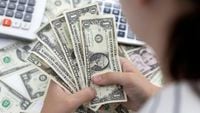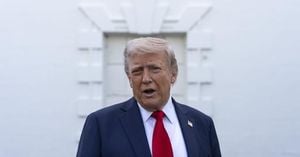The Mexican peso appreciated significantly against the U.S. dollar on Monday, April 14, 2025, as international economic conditions improved following a temporary reduction in tariffs on Chinese electronics by the U.S. government. The interbank exchange rate opened at approximately 20.08 pesos per dollar, reflecting a recovery of 24.1 centavos compared to the previous closing. This appreciation, which translates to a daily gain of 0.60%, marks a positive shift for the peso amidst a backdrop of decreased risk aversion in global markets.
The recent decision by the U.S. to temporarily lower tariffs on imports of cell phones, computers, and other electronic devices from China has been interpreted as a sign of easing tensions in the ongoing trade conflict between the two economic superpowers. Analysts from CIBanco noted, "The Mexican exchange market, like global markets, will remain very dependent on the issue of Trump’s tariffs, particularly if bilateral agreements are announced that allow for a reduction in levies." This sentiment was echoed by market observers who expressed optimism about the potential for improved trade relations.
The peso's performance is notable, showing a weekly advance of 2.50%, despite a monthly decline of 1.20%. The dollar index, which measures the performance of the U.S. currency against a basket of foreign currencies, fell by 0.71% on the same day, indicating a decrease in demand for safe-haven assets. Other currencies, including the euro and the British pound, also saw gains against the dollar, with the euro rising 0.29% and the pound advancing 0.69%.
In the digital asset space, Bitcoin experienced a resurgence, climbing 1.69% as investor sentiment improved amid broader market optimism. This recovery in cryptocurrencies aligns with the overall positive sentiment in emerging market currencies, including the Mexican peso.
Looking ahead, the peso is expected to maintain its momentum if the trend of reduced global risk aversion continues, coupled with supportive economic data from both the U.S. and Asia. The current environment suggests a potential for increased capital flows into emerging markets, which would further bolster the peso's strength against the dollar.
Meanwhile, in Peru, the exchange rate for the dollar also saw movements on April 14, 2025, closing at S/3.7410 according to the Central Reserve Bank of Peru (BCR). In the parallel market, the dollar was trading at S/3.710 for purchase and S/3.70 for sale. The BCR's latest figures reflect a modest increase in the value of the sol against the dollar, despite uncertainties stemming from the U.S. tariffs imposed by President Donald Trump.
Peru's economy, which successfully rebounded from a contraction in 2024, is projected to grow by 3.2% in 2025, up from an earlier estimate of 3.1%. This growth is anticipated to be supported by a recovery in private consumption and the potential for significant international investment, estimated between $20 billion and $30 billion, contingent on the approval of structural reforms aimed at fostering private investment.
Despite ongoing political challenges, the Peruvian sol has demonstrated resilience, emerging as a stable currency within the region. Analysts have noted that the sol's strength against other currencies, including the dollar and the euro, positions it as a potential safe haven for investors, particularly in neighboring countries experiencing currency shortages.
As the week progresses, both the Mexican peso and the Peruvian sol will be closely watched by investors, especially in light of upcoming economic data releases. The U.S. is set to publish import and export price indexes on April 15, followed by retail sales and industrial production data on April 16, which could further influence currency valuations.
In conclusion, the recent performance of the Mexican peso reflects a broader trend of increased investor confidence in emerging markets, bolstered by favorable international trade developments. As economic indicators begin to emerge, the trajectory of both the peso and the sol will be pivotal in shaping market expectations.








